350 Search Results for aided language input
June 22, 2020
by Carole Zangari -
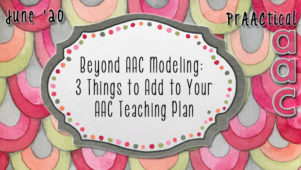
It is hard to overstate the role of aided language input and other forms of AAC modeling when interacting with those who are still developing their language and communication skills. Seeing and hearing others use AAC is important for many reasons. Some AAC users pick up language and AAC skills just through that kind of exposure. Most, however, benefit from explicit instruction on specific skills, such as creating longer and more complex sentences, using morphological endings to change the form of the word, or expanding the range of words they use. They also need support to move from using these skills only during therapy/instruction to using them in a range of functional contexts. Here are some things to add to our intervention to strengthen their AAC learning. Think Aloud Strategy: Narrate the steps of finding what you want to say in their AAC system as you create your message (e..g.,... [Read More...]
June 8, 2020
by Carole Zangari -
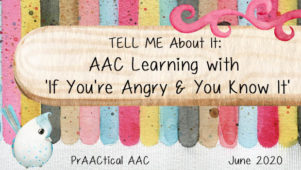
Welcome to a new edition of TELL ME ABout It, a series looking at ways to use children’s trade books to build AAC core vocabulary and literacy skills. Maggie Judson and Jeanna Antrim are back with more great ideas for AAC intervention, this time focusing on the book, ‘If You’re Angry and You Know It.’ Maggie and Jeanna are speech-language pathologists who work in the Assistive Technology Department for the Belleville Area Special Services Cooperative (BASSC) in central Illinois. They are AT/AAC facilitators and provide evaluations, direct therapy, consultations, and trainings. You can see their previous posts in the TELL ME About It series below. The Lunch Box Surprise Come Out and Play, Little Mouse No, David Go Away Big Green Monster What Do You Like? Here Are My Hands From Head to Toe I Went Walking Brown Bear, Brown Bear TELL ME AAC Literacy Kits Don’t miss their videos... [Read More...]
June 4, 2020
by Carole Zangari -
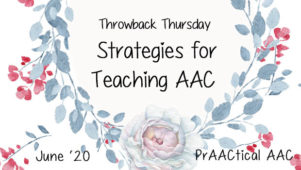
Engaging activities and materials are important in AAC instruction, but the real magic happens when we implement appropriate intervention strategies with fidelity and on a consistent basis. For Throwback Thursday, we raided the archives to revisit some previous posts on several key intervention strategies. Aided Language Input: How Much Language Should We Model? Aided Language Input in AACtion “I’m Using Aided Language Input. Now what??” From Referential to Descriptive Teaching with AAC Learners Recasting: A Language Facilitation Strategy F is for Feedback
May 11, 2020
by Carole Zangari -
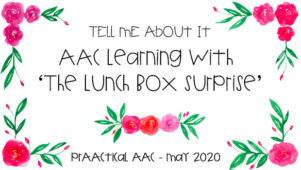
Reading with preschoolers is a great way to build language and AAC skills. Today, we share another post in the TELL ME About It series on incorporating AAC, language, and literacy support with young learnes.. Maggie Judson and Jeanna Antrim are back with more great ideas for AAC intervention, this time focusing on the book, Come Out and Play, Little Mouse. Maggie and Jeanna are speech-language pathologists who work in the Assistive Technology Department for the Belleville Area Special Services Cooperative (BASSC) in central Illinois. They are AT/AAC facilitators and provide evaluations, direct therapy, consultations, and trainings. To read more about how this team prepares for a TELL ME week, check out their previous posts in the TELL ME About It series. Come Out and Play, Little Mouse No, David Go Away Big Green Monster What Do You Like? Here Are My Hands From Head to Toe I Went Walking... [Read More...]
May 4, 2020
by Carole Zangari -
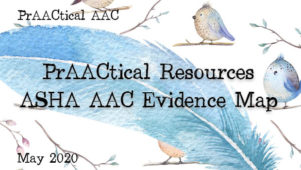
May is Better Hearing and Speech Month here in the US and in celebration of that, today’s post features an important resource from the American Speech-Language-Heating Association. The AAC Evidence Map was launched a few years ago and has been growing steadily since that time. ASHA’s Evidence Maps call attention to the three pillars of evidence-based practice (EBP): scientific evidence, clinical expertise, and client values/perspectives They were created for many different areas within the field of speech-language pathology and address clinical services across disability and age groups. Each of the 40+ evidence maps includes information on assessment, intervention, and service delivery for that specific communication difficulty. The information in each one comes from a variety of sources, including refereed journals and professional organizations in several countries. The AAC Evidence Map includes two types of external scientific information, Clinical Guidelines, and systematic reviews. Individuals studies are not included here. There are... [Read More...]
April 13, 2020
by Carole Zangari -
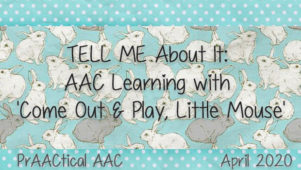
It’s time for another edition of the TELL ME About It series which focuses on AAC, language, and literacy learning with preschool children. Maggie Judson and Jeanna Antrim are back with more great ideas for AAC intervention, this time focusing on the book, Come Out and Play, Little Mouse. Maggie and Jeanna are speech-language pathologists who work in the Assistive Technology Department for the Belleville Area Special Services Cooperative (BASSC) in central Illinois. They are AT/AAC facilitators and provide evaluations, direct therapy, consultations, and trainings. You can check out the earlier posts in this series below. No, David Go Away Big Green Monster What Do You Like? Here Are My Hands From Head to Toe I Went Walking Brown Bear, Brown Bear TELL ME AAC Literacy Kits Be sure to see their videos modeling book reading with two AAC systems toward the end of this post. TELL ME About It:... [Read More...]
March 12, 2020
by Carole Zangari -
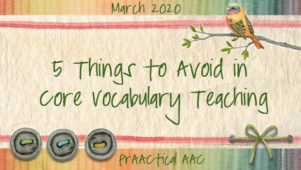
There’s no doubt that core vocabulary plays an important role for the majority of people with AAC needs. When using and teaching them, however, there are some common pitfalls. Here are some thoughts on avoiding them. Don’t equate high-frequency words with ‘first words.’ There is some overlap in core vocabulary and an initial lexicon but they are different things. Both are important. Don’t assume that just because someone has a significant intellectual disability that core vocabulary is irrelevant or too difficult. Many, many people with complex communication needs who have significant cognitive impairments have been successful in learning to use these words. Don’t limit the AAC learner to only core words. If we exclude words that are of great interest or highly motivating, we take the fun out of communication. Don’t get stuck with just the root word. Instead, use various forms of the word (e.g., go, goes, going; big,... [Read More...]
March 9, 2020
by Carole Zangari -
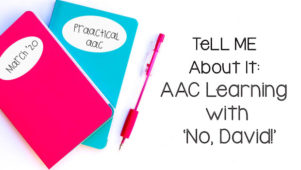
Maggie Judson and Jeanna Antrim are back with another guest post in the series, TELL ME About It. These two AAC SLPs work in the Assistive Technology Department for the Belleville Area Special Services Cooperative (BASSC) in southern Illinois. In today’s post, they cover ways to promote AAC use while focusing on the book ‘No, David!’ In this series, they discuss how they support preschool teachers who are implementing the TELL ME program with their young students. Maggie and Jeanna are both AT/AAC facilitators who provide evaluations, direct therapy, and consultations, and train school teams on AAC implementation. Enjoy their prAACtical suggestions and don’t miss their Lesson Plan, video demonstrations, and other resources at the end of the post. TELL ME About It: AAC Learning with ‘No, David!’ TELL ME About Reading: The seventh book in the TELL ME program (Teaching Early Language and Literacy through Multimodal Expression) is “No,... [Read More...]
March 5, 2020
by Carole Zangari -
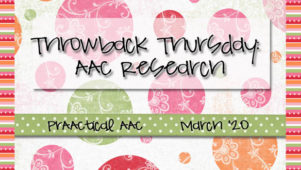
It’s Throwback Thursday and today we’ve reached into the archives to revisit past posts on research in the field of AAC. Enjoy! PrAACtical Research with Kathy Howery Profiles of Students with Significant Cognitive Disabilities AAC Intervention for Children with ASD Aided Language Input for People with Developmental Disabilities Meta-synthesis of AAC Team Members’ Voices Effects of Parent Instruction on SGD Use Recasts in AAC Mediated Interaction Research Support for Aided Language Input AAC & Challenging Behavior Research Tuesday: Photos Versus PCS – Babies Weigh In Literacy Instruction for Students with Significant Disabilities Comparing Picture Exchange and SGDs Research Reviews Supporting the Use of AAC Supporting Children with Severe and Profound Multiple Disabilities Sensory Intervention for Individuals with ASD: What Does the Research Say?
February 24, 2020
by Carole Zangari -
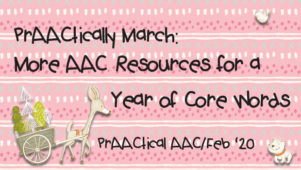
Do the AAC users in your life use only a fraction of the core words in their SGD, AAC app, or communication board? One way to help them move forward is to make a concerted effort to use, highlight, and provide additional teaching on a variety of words. It’s hard to do this without getting overwhelmed, so find a strategy that works for you. A few years ago, we decided to approach this by focusing on 12-16 core words each month. (If this is too much for the teams with whom you work, that’s not a problem. Just cut it back to 4-6 words/month.) Each month, we can highlight those words in our conversation (aided language input), direct intervention, and home programming activities with AAC learners. The repeated experiences with those 12-16 (or 4-6) words help our AAC learners develop new skills, and keeps the team focused on the same destination. ... [Read More...]









